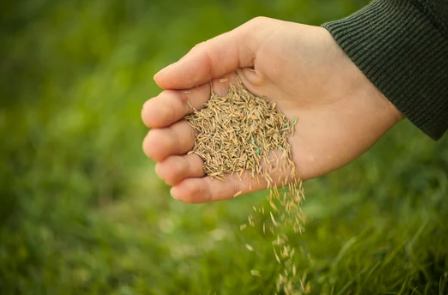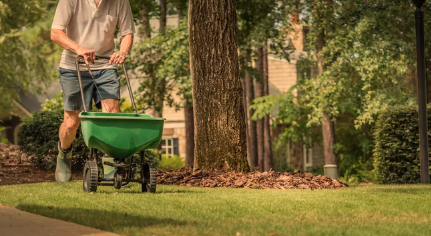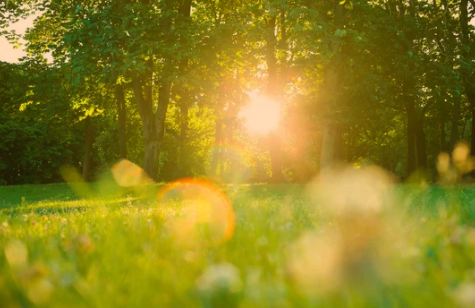Maintaining a lush, vibrant lawn in shady areas can be a challenge.
Limited sunlight and competition from trees and buildings can hinder the growth of grass.
However, with the right grass seed, you can transform those shady patches into green havens.
In this blog post, we’ll explore the best grass seed options specifically tailored for shady areas, helping you achieve a thriving and beautiful lawn.
The Challenges Of Grass Seed
Before diving into the grass seed varieties suitable for shady areas, it’s crucial to understand the challenges these spaces present.
Shady spots typically have reduced sunlight and increased moisture levels due to limited airflow and longer drying times.
As a result, grass in these areas often struggles to establish deep root systems, leading to sparse growth and increased susceptibility to diseases and pests.
What is The Best Grass Seed For Shady Areas?

Selecting the Right Grass Seed:
When choosing the best grass seed for shady areas, consider the following factors:
- Shade Tolerance: Look for grass seed varieties specifically developed for shade tolerance. These varieties are bred to thrive in low light conditions and have characteristics that promote growth with less sunlight. They often have broader and longer leaves to capture as much light as possible.
- Fine Fescue Blends: Fine fescue grass seed blends, such as creeping red fescue, chewings fescue, and hard fescue, are excellent choices for shady areas. These grasses have a higher shade tolerance, adapt well to various soil conditions, and require less maintenance. Fine fescues are known for their ability to grow in low light and their tolerance for cooler temperatures.
- Perennial Ryegrass: Perennial ryegrass is another viable option for shady spots. It germinates quickly and establishes a dense, attractive lawn. While it may not tolerate deep shade as well as fescue, it can thrive in areas with moderate shade and receives occasional sunlight. Perennial ryegrass blends well with other grass seed varieties and adds a vibrant green color to the lawn.
- Mixtures and Blends: Consider using grass seed mixtures or blends designed explicitly for shade. These blends combine different grass varieties with varying shade tolerance levels to create a balanced, resilient lawn. Look for mixtures containing fescue, ryegrass, and shade-tolerant bluegrass. The mixture ensures that you have a combination of grasses that can adapt to varying levels of shade and sunlight in your lawn.
- Soil Conditions: Evaluate the soil conditions in your shady area. Ensure that the grass seed you choose is suitable for the soil type, pH level, and moisture retention capacity of your specific location. Conduct a soil test to determine the soil’s characteristics and make amendments as necessary to create an optimal growing environment for the grass.
Tips for Successful Seeding

To increase the chances of success, keep the following tips in mind when planting grass seed in shady areas:
- Soil Preparation: Prepare the soil by removing debris, aerating, and loosening it to improve drainage. Add organic matter like compost to enhance soil quality and water retention. Improved soil structure allows better root development and nutrient uptake, leading to healthier grass growth.
- Light Pruning: Trim lower branches of trees or shrubs to allow more light penetration to the grassy areas. However, avoid over-pruning, as it may damage the trees or shrubs. Pruning strategically can help create a dappled shade, which is more conducive to grass growth.
- Seed Sowing: Follow the instructions on the grass seed packaging regarding seeding rates and depth. Ensure good seed-to-soil contact by raking the soil lightly after seeding. Broadcasting the seed evenly and avoiding clumping will promote even germination and growth.
- Adequate Watering: Water the seeded area regularly to keep the soil moist, but avoid overwatering. Shady areas may require less water compared to sunny areas, so adjust watering accordingly. Deep, infrequent watering encourages the development of deep roots, making the grass more resilient to drought conditions.
- Proper Maintenance: Implement a regular lawn maintenance routine that includes mowing at the appropriate height and fertilizing as needed. Aerate the soil periodically to improve airflow and nutrient absorption. Avoid cutting the grass too short, as longer grass blades promote photosynthesis and shade the soil, reducing weed competition.
Importance of Shade Tolerance Ratings

When researching different grass seed varieties, pay attention to their shade tolerance ratings. These ratings indicate the grass’s ability to thrive in low light conditions. Grasses with higher shade tolerance ratings will perform better in areas with dense shade, while those with moderate shade tolerance may do well in spots with partial sunlight.
Consider Dappled Shade
In some cases, shady areas may experience dappled shade, which is a combination of sunlight and shade caused by filtering through tree canopies. Dappled shade can be more conducive to grass growth compared to deep shade. Consider grass seed varieties that can tolerate both shade and some sunlight, such as certain fine fescues and shade-tolerant bluegrasses.
Test and Improve Soil
Conduct a soil test to assess the pH level, nutrient content, and texture of the soil in your shady area. This information will help you select the appropriate grass seed and determine if any soil amendments, such as lime or organic matter, are needed to optimize growing conditions. Adjusting the soil pH and improving its structure will support healthy grass growth.
Overseeding Existing Lawns:

If you have an existing lawn in a shady area that is thinning or struggling, consider overseeding with shade-tolerant grass seed. Overseeding helps fill in bare patches and improves the overall density and health of the lawn. Ensure proper seed-to-soil contact by aerating the lawn before overseeding and follow up with regular watering and maintenance.
Pest and Disease Management
Shady areas can be more susceptible to certain pests and diseases due to reduced airflow and longer periods of moisture. Monitor your lawn closely for signs of fungal diseases, such as brown patch or dollar spot, and address them promptly with appropriate treatments. Regularly inspect for pests like grubs or shade-loving insects and take necessary control measures if infestations occur.
Consider Alternative Ground Covers:
In extremely shady areas where it is difficult to establish grass, consider alternative ground cover options. Shade-loving plants like mosses, ferns, or ground cover such as vinca minor or ajuga can be used to create a green and visually appealing ground cover. These alternatives can be combined with grass seed in partially shaded areas to create an interesting and diverse landscape.
Remember, successfully growing grass in shady areas requires patience and adaptation.
It may take time for the grass seed to establish and develop a healthy root system.
Adjust your expectations accordingly, and be prepared to provide consistent care and maintenance to ensure the long-term health and beauty of your shady lawn.
Conclusion
Creating a thriving lawn in shady areas is possible with the right grass seed and proper care.
When choosing the right shade-tolerant grass seed varieties, preparing the soil adequately, and maintaining a consistent watering and maintenance schedule, you can transform those once troublesome patches into lush, green spaces.
Experiment with different grass seed options and find the one that suits your specific shade conditions and preferences.
With time, patience, and some TLC, your shady lawn can become a verdant oasis for you to enjoy for years to come.
Reference
- “Best Grass Seed for Shade: How to Choose and Grow Shade-Tolerant Grass” by The Old Farmer’s Almanac: https://www.almanac.com/content/best-grass-seed-shade
- “Lawn Grass for Shade – Shade Tolerant Grass Varieties” by The Lawn Institute: https://thelawninstitute.org/lawn-grass-species/shade-tolerant-grass-varieties/
- “Choosing the Right Grass Seed for Shade” by Penn State Extension: https://extension.psu.edu/choosing-the-right-grass-seed-for-shade
